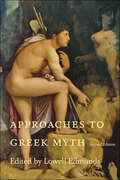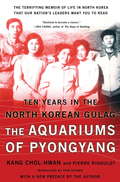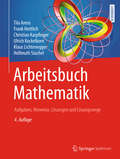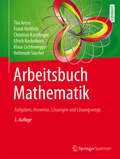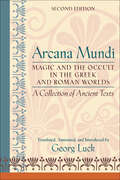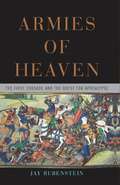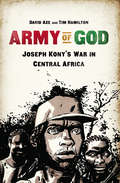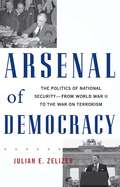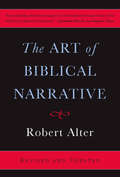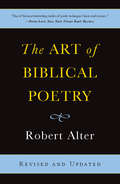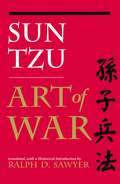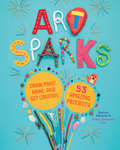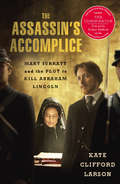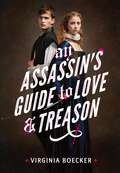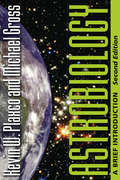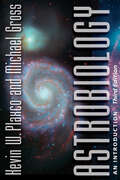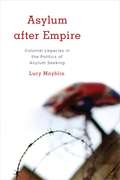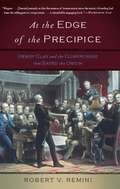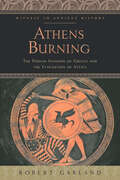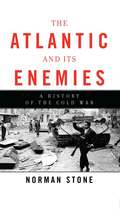- Table View
- List View
Approaches to Greek Myth
by Lowell EdmundsSince the first edition of Approaches to Greek Myth was published in 1990, interest in Greek mythology has surged. There was no simple agreement on the subject of "myth" in classical antiquity, and there remains none today. Is myth a narrative or a performance? Can myth be separated from its context? What did myths mean to ancient Greeks and what do they mean today? Here, Lowell Edmunds brings together practitioners of eight of the most important contemporary approaches to the subject. Whether exploring myth from a historical, comparative, or theoretical perspective, each contributor lucidly describes a particular approach, applies it to one or more myths, and reflects on what the approach yields that others do not. Edmunds's new general and chapter-level introductions recontextualize these essays and also touch on recent developments in scholarship in the interpretation of Greek myth. Contributors are Jordi Pà mias, on the reception of Greek myth through history; H. S. Versnel, on the intersections of myth and ritual; Carolina López-Ruiz, on the near Eastern contexts; Joseph Falaky Nagy, on Indo-European structure in Greek myth; William Hansen, on myth and folklore; Claude Calame, on the application of semiotic theory of narrative; Christiane Sourvinou-Inwood, on reading visual sources such as vase paintings; and Robert A. Segal, on psychoanalytic interpretations.
The Aquariums of Pyongyang: Ten Years in the North Korean Gulag
by Pierre Rigoulot Chol-hwan Kang"Destined to become a classic" (Iris Chang, author of The Rape of Nanking), this harrowing memoir of life inside North Korea was the first account to emerge from the notoriously secretive country -- and it remains one of the most terrifying. Amid escalating nuclear tensions, Kim Jong-un and North Korea's other leaders have kept a tight grasp on their one-party state, quashing any nascent opposition movements and sending all suspected dissidents to its brutal concentration camps for "re-education." Kang Chol-Hwan is the first survivor of one of these camps to escape and tell his story to the world, documenting the extreme conditions in these gulags and providing a personal insight into life in North Korea. Sent to the notorious labor camp Yodok when he was nine years old, Kang observed frequent public executions and endured forced labor and near-starvation rations for ten years. In 1992, he escaped to South Korea, where he found God and now advocates for human rights in North Korea.Part horror story, part historical document, part memoir, part political tract, this book brings together unassailable firsthand experience, setting one young man's personal suffering in the wider context of modern history, giving eyewitness proof to the abuses perpetrated by the North Korean regime.
Arbeitsbuch Mathematik: Aufgaben, Hinweise, Lösungen und Lösungswege
by Tilo Arens Frank Hettlich Christian Karpfinger Ulrich Kockelkorn Klaus Lichtenegger Hellmuth StachelDieses Arbeitsbuch enthält die Aufgaben, Hinweise, Lösungen und Lösungswege zu allen sechs Teilen des Lehrbuchs Arens et al., Mathematik. Die Inhalte des Buchs stehen als pdf-Dateien auch auf der Website zum Buch matheweb zur Verfügung.Durch die stufenweise Offenlegung der Lösungen ist das Werk bestens geeignet zum Selbststudium, zur Vorlesungsbegleitung und als Prüfungsvorbereitung. Inhaltlich spannt sich der Bogen von elementaren Grundlagen über die Analysis einer Veränderlichen, der linearen Algebra, der Analysis mehrerer Veränderlicher bis hin zu fortgeschrittenen Themen der Analysis, die für die Anwendung besonders wichtig sind, wie partielle Differenzialgleichungen, Fourierreihen und Laplacetransformationen. Auch eine Vielzahl von Aufgaben zur Wahrscheinlichkeitsrechnung und Statistik ist enthalten. Auf der Website zum Buch matheweb besteht die Möglichkeit, Verständnisfragen zu den Aufgaben zu stellen.
Arbeitsbuch Mathematik: Aufgaben, Hinweise, Lösungen und Lösungswege
by Tilo Arens Frank Hettlich Christian Karpfinger Ulrich Kockelkorn Klaus Lichtenegger Hellmuth StachelDieses Arbeitsbuch enthält die Aufgaben, Hinweise, Lösungen und Lösungswege zu allen sechs Teilen des Lehrbuchs Arens et al., Mathematik. Die Inhalte des Buchs stehen als pdf-Dateien auch auf der Website zum Buch matheweb zur Verfügung.Durch die stufenweise Offenlegung der Lösungen ist das Werk bestens geeignet zum Selbststudium, zur Vorlesungsbegleitung und als Prüfungsvorbereitung. Inhaltlich spannt sich der Bogen von elementaren Grundlagen über die Analysis einer Veränderlichen, der linearen Algebra, der Analysis mehrerer Veränderlicher bis hin zu fortgeschrittenen Themen der Analysis, die für die Anwendung besonders wichtig sind, wie partielle Differenzialgleichungen, Fourierreihen und Laplacetransformationen. Auch eine Vielzahl von Aufgaben zur Wahrscheinlichkeitsrechnung und Statistik ist enthalten. Auf der Website zum Buch matheweb besteht die Möglichkeit, Verständnisfragen zu den Aufgaben zu stellen.
Arcana Mundi: Magic and the Occult in the Greek and Roman Worlds: A Collection of Ancient Texts (Textes Litteraires Du Moyen Age Ser. #21)
by Georg LuckMagic, miracles, daemonology, divination, astrology, and alchemy were the arcana mundi, the "secrets of the universe," of the ancient Greeks and Romans. In this path-breaking collection of Greek and Roman writings on magic and the occult, Georg Luck provides a comprehensive sourcebook and introduction to magic as it was practiced by witches and sorcerers, magi and astrologers, in the Greek and Roman worlds. In this new edition, Luck has gathered and translated 130 ancient texts dating from the eighth century BCE through the fourth century CE. Thoroughly revised, this volume offers several new elements: a comprehensive general introduction, an epilogue discussing the persistence of ancient magic into the early Christian and Byzantine eras, and an appendix on the use of mind-altering substances in occult practices. Also added is an extensive glossary of Greek and Latin magical terms. In Arcana Mundi Georg Luck presents a fascinating—and at times startling—alternative vision of the ancient world. "For a long time it was fashionable to ignore the darker and, to us, perhaps, uncomfortable aspects of everyday life in Greece and Rome," Luck has written. "But we can no longer idealize the Greeks with their 'artistic genius' and the Romans with their 'sober realism.' Magic and witchcraft, the fear of daemons and ghosts, the wish to manipulate invisible powers—all of this was very much a part of their lives."
Armies of Heaven: The First Crusade and the Quest for Apocalypse
by Jay RubensteinAt Moson, the river Danube ran red with blood. At Antioch, the Crusaders- their saddles freshly decorated with sawed-off heads-indiscriminately clogged the streets with the bodies of eastern Christians and Turks. At Ma'arra, they cooked children on spits and ate them. By the time the Crusaders reached Jerusalem, their quest-and their violence- had become distinctly otherworldly: blood literally ran shin-deep through the streets as the Crusaders overran the sacred city. Beginning in 1095 and culminating four bloody years later, the First Crusade represented a new kind of warfare: holy, unrestrained, and apocalyptic. In Armies of Heaven, medieval historian Jay Rubenstein tells the story of this cataclysmic event through the eyes of those who witnessed it, emphasizing the fundamental role that apocalyptic thought played in motivating the Crusaders. A thrilling work of military and religious history, Armies of Heaven will revolutionize our understanding of the Crusades.
Army of God: Joseph Kony's War in Central Africa
by David Axe Tim HamiltonJoseph Kony is the most dangerous guerilla leader in modern African history.It started with a visit from spirits. In 1991, Kony claimed that spiritual beings had come to him with instructions: he was to lead his group of rebels, the Lord's Resistance Army, in a series of brutal raids against ordinary Ugandan civilians. Decades later, Kony has sown chaos throughout Central Africa, kidnapping and terrorizing countless innocents—especially children. Yet despite an enormous global outcry, the Kony 2012 movement, and an international military intervention, the carnage has continued. Drawn from on-the-ground reporting by war correspondent David Axe and starkly illustrated by Tim Hamilton, Army of God is the first-ever graphic account of the global phenomenon surrounding Kony—from the devastation he has left behind to the long campaign to defeat him for good.
Arsenal of Democracy: The Politics of National Security--From World War II to the War on Terrorism
by Julian E. ZelizerIt has long been a truism that prior to George W. Bush, politics stopped at the water&’s edge—that is, that partisanship had no place in national security. In Arsenal of Democracy, historian Julian E. Zelizer shows this to be demonstrably false: partisan fighting has always shaped American foreign policy and the issue of national security has always been part of our domestic conflicts. Based on original archival findings, Arsenal of Democracy offers new insights into nearly every major national security issue since the beginning of the cold war: from FDR&’s masterful management of World War II to the partisanship that scarred John F. Kennedy during the Cuban Missile Crisis, from Ronald Reagan&’s fight against Communism to George W. Bush&’s controversial War on Terror. A definitive account of the complex interaction between domestic politics and foreign affairs over the last six decades, Arsenal of Democracy is essential reading for anyone interested in the politics of national security.
The Art of Biblical Narrative
by Robert AlterFrom celebrated translator of the Hebrew Bible Robert Alter, the classic study of the Bible as literature, a winner of the National Jewish Book AwardRenowned critic and translator Robert Alter's The Art of Biblical Narrative has radically expanded our view of the Bible by recasting it as a work of literary art deserving studied criticism. In this seminal work, Alter describes how the Hebrew Bible's many authors used innovative literary styles and devices such as parallelism, contrastive dialogue, and narrative tempo to tell one of the most revolutionary stories of all time: the revelation of a single God. In so doing, Alter shows, these writers reshaped not only history, but also the art of storytelling itself.
The Art of Biblical Poetry
by Robert AlterThree decades ago, renowned literary expert Robert Alter radically expanded the horizons of biblical scholarship by recasting the Bible as not only a human creation but a work of literary art deserving studied criticism. In The Art of Biblical Poetry, his companion to the seminal The Art of Biblical Narrative, Alter takes his analysis beyond narrative craft to investigate the use of Hebrew poetry in the Bible. Updated with a new preface, myriad revisions, and passages from Alter's own critically acclaimed biblical translations, The Art of Biblical Poetry is an indispensable tool for understanding the Bible and its poetry.
The Art of War: Sun Tzu's Classic In Plain English With Sun Pin's The Art Of Warfare (Penguin Modern Classics Ser. #909)
by Tzu SunThe definitive translation of Sun-tzu's timeless classic of military strategy, Art of WarArt of War is almost certainly the most famous study of strategy ever written and has had an extraordinary influence on the history of warfare. The principles Sun-tzu expounded were utilized brilliantly by such great Asian war leaders as Mao Tse-tung, Giap, and Yamamoto. First translated two hundred years ago by a French missionary, Sun-tzu's Art of War has been credited with influencing Napoleon, the German General Staff, and even the planning for Desert Storm. Many Japanese companies make this book required reading for their key executives. And increasingly, Western businesspeople and others are turning to the Art of War for inspiration and advice on how to succeed in competitive situations of all kinds. Unlike most editions of Sun-tzu currently available (many simply retreads of older, flawed translations), this superb translation makes use of the best available classical Chinese manuscripts, including the ancient "tomb text" version discovered by archaeologists at Linyi, China. Ralph Sawyer, an outstanding Western scholar of ancient Chinese warfare and a successful businessman in his own right, places this classic work of strategy in its proper historical context. Sawyer supplies a portrait of Sun-tzu's era and outlines several battles of the period that may have either influenced Sun-tzu or been conducted by him. While appreciative of the philosophical richness of the Art of War, this edition stresses Sun-tzu's practical origins and presents a translation that is both accurate and accessible.
Art Sparks: Draw, Paint, Make, and Get Creative with 53 Amazing Projects!
by Marion Abrams Hilary Emerson LayThis lively, colorful compendium of arts and crafts for a new generation of kids features projects specially designed to spark creativity, invite self-expression, and nurture self-confidence. From finger puppets to fabric flags to shrink art, each activity uses inexpensive materials and can be crafted in less than 90 minutes.
The Assassin's Accomplice: Mary Surratt and the Plot to Kill Abraham Lincoln
by Kate Clifford LarsonIn The Assassin's Accomplice, historian Kate Clifford Larson tells the gripping story of Mary Surratt, a little-known participant in the plot to kill Abraham Lincoln, and the first woman ever to be executed by the federal government of the United States. Surratt, a Confederate sympathizer, ran the boarding house in Washington where the conspirators-including her rebel son, John Surratt-met to plan the assassination. When a military tribunal convicted her for her crimes and sentenced her to death, five of the nine commissioners petitioned President Andrew Johnson to show mercy on Surratt because of her sex and age. Unmoved, Johnson refused-Surratt, he said, "kept the nest that hatched the egg.” Set against the backdrop of the Civil War, The Assassin's Accomplice tells the intricate story of the Lincoln conspiracy through the eyes of its only female participant. Based on long-lost interviews, confessions, and court testimony, the text explores how Mary's actions defied nineteenth-century norms of femininity, piety, and motherhood, leaving her vulnerable to deadly punishment historically reserved for men. A riveting narrative account of sex, espionage, and murder cloaked in the enchantments of Southern womanhood, The Assassin's Accomplice offers a fresh perspective on America's most famous murder.
The Assassin's Accomplice: Mary Surratt and the Plot to Kill Abraham Lincoln
by Kate Clifford LarsonIn The Assassin's Accomplice, historian Kate Clifford Larson tells the gripping story of Mary Surratt, a little-known participant in the plot to kill Abraham Lincoln, and the first woman ever to be executed by the federal government of the United States. Surratt, a Confederate sympathizer, ran the boarding house in Washington where the conspirators-including her rebel son, John Surratt-met to plan the assassination. When a military tribunal convicted her for her crimes and sentenced her to death, five of the nine commissioners petitioned President Andrew Johnson to show mercy on Surratt because of her sex and age. Unmoved, Johnson refused-Surratt, he said, "kept the nest that hatched the egg." Set against the backdrop of the Civil War, The Assassin's Accomplice tells the intricate story of the Lincoln conspiracy through the eyes of its only female participant. Based on long-lost interviews, confessions, and court testimony, the text explores how Mary's actions defied nineteenth-century norms of femininity, piety, and motherhood, leaving her vulnerable to deadly punishment historically reserved for men. A riveting narrative account of sex, espionage, and murder cloaked in the enchantments of Southern womanhood, The Assassin's Accomplice offers a fresh perspective on America's most famous murder.
An Assassin's Guide to Love and Treason
by Virginia BoeckerShakespeare in Love meets Mr. and Mrs. Smith in this witty and thrilling story of star-crossed assassins in Elizabeth England, perfect for fans of My Lady Jane and TheGentleman's Guide to Vice and Virtue! When Lady Katherine's father is killed for being an illegally practicing Catholic, she discovers treason wasn't the only secret he's been hiding: he was also involved in a murder plot against the reigning Queen Elizabeth I. With nothing left to lose, Katherine disguises herself as a boy and travels to London to fulfill her father's mission, and to take it one step further -- kill the queen herself. Katherine's opportunity comes in the form of William Shakespeare's newest play, which is to be performed in front of Her Majesty. But what she doesn't know is that the play is not just a play. It's a plot to root out insurrectionists and destroy the rebellion once and for all. The mastermind behind this ruse is Toby Ellis, a young spy for the queen with secrets of his own. When Toby and Katherine are cast opposite each other as the play's leads, they find themselves inexplicably drawn to one another. But the closer they grow, the more precarious their positions become. And soon they learn that star-crossed love, mistaken identity, and betrayal are far more dangerous off the stage than on.
Astrobiology: A Brief Introduction
by Michael Gross Kevin W. PlaxcoInformed by new planetary discoveries and the findings from recent robotic missions to Mars, Jupiter, and Saturn, scientists are rapidly replacing centuries of speculation about potential extraterrestrial habitats with real knowledge about the possibility of life outside our own biosphere—if it exists, and where. This second edition of Kevin W. Plaxco and Michael Gross’s widely acclaimed text incorporates the latest research in astrobiology to bring readers the most comprehensive, up-to-date, and engaging introduction to the field available.Plaxco and Gross expand their examination of the origin of chemical elements, the developments that made the Universe habitable, and how life continues to be sustained. They discuss in great detail the formation of the first galaxies and stars, the diverse chemistry of the primordial planet, the origins of metabolism, the evolution of complex organisms, and the feedback regulation of Earth's climate. They also explore life in extreme habitats, potential extraterrestrial habitats, and the current status of the search for extraterrestrial life.Weaving together the relevant threads of astronomy, geology, chemistry, biophysics, and microbiology, this broadly accessible introductory text captures the excitement, controversy, and progress of the dynamic young field of astrobiology. New to this edition is a glossary of terms and an epilogue recapping the key unanswered questions, making Astrobiology an ideal primer for students and, indeed, for anyone curious about life and the Universe.
Astrobiology: A Brief Introduction
by Kevin W. Plaxco Michael GrossInformed by new planetary discoveries and the findings from recent robotic missions to Mars, Jupiter, and Saturn, scientists are rapidly replacing centuries of speculation about potential extraterrestrial habitats with real knowledge about the possibility of life outside our own biosphere—if it exists, and where. This second edition of Kevin W. Plaxco and Michael Gross’s widely acclaimed text incorporates the latest research in astrobiology to bring readers the most comprehensive, up-to-date, and engaging introduction to the field available.Plaxco and Gross expand their examination of the origin of chemical elements, the developments that made the Universe habitable, and how life continues to be sustained. They discuss in great detail the formation of the first galaxies and stars, the diverse chemistry of the primordial planet, the origins of metabolism, the evolution of complex organisms, and the feedback regulation of Earth's climate. They also explore life in extreme habitats, potential extraterrestrial habitats, and the current status of the search for extraterrestrial life.Weaving together the relevant threads of astronomy, geology, chemistry, biophysics, and microbiology, this broadly accessible introductory text captures the excitement, controversy, and progress of the dynamic young field of astrobiology. New to this edition is a glossary of terms and an epilogue recapping the key unanswered questions, making Astrobiology an ideal primer for students and, indeed, for anyone curious about life and the Universe.
Astrobiology: An Introduction
by Kevin W. Plaxco Michael GrossExploring the potential for extraterrestrial life and the origins of our own planet, this comprehensive introduction to astrobiology is updated with the latest findings.Informed by the discoveries and analyses of extrasolar planets and the findings from recent robotic missions across the solar system, scientists are rapidly replacing centuries of speculation about potential extraterrestrial habitats with real knowledge about the possibility of life outside our own biosphere—if it exists, and, if so, where. Casting new light on the biggest questions there are—how did we get here, and who else might be out there?—this third edition of Kevin W. Plaxco and Michael Gross's widely acclaimed Astrobiology incorporates a decade's worth of new developments in space to bring readers the most comprehensive, up-to-date, and engaging introduction to the field available.Plaxco and Gross examine the factors that make our Universe habitable, from the origin of chemical elements and the formation of the first galaxies and stars to the birth and composition of the planets. They describe the latest thinking about the origins of life, explain the evolution of metabolism and the development of complex organisms. In order to assess the limits for life elsewhere, they also explore life in extreme habitats and reveal how it informs the search for potential extraterrestrial habitats—ones that might support extraterrestrial life. New and updated illustrations enhance the book throughout.Sharing fascinating findings from the comet mission Dawn, the visit of New Horizons to Pluto, and the work of the Deep Carbon Observatory, which has revealed an incredible underground biosphere within our own planet, Plaxco and Gross weave together cosmology, astrophysics, geology, biochemistry, biophysics, and microbiology. From neutron star mergers to the survival skills of tardigrades, this fascinating book is an ideal primer for students or anyone curious about life and the Universe.
Astrobiology: An Introduction
by Kevin W. Plaxco Michael GrossExploring the potential for extraterrestrial life and the origins of our own planet, this comprehensive introduction to astrobiology is updated with the latest findings.Informed by the discoveries and analyses of extrasolar planets and the findings from recent robotic missions across the solar system, scientists are rapidly replacing centuries of speculation about potential extraterrestrial habitats with real knowledge about the possibility of life outside our own biosphere—if it exists, and, if so, where. Casting new light on the biggest questions there are—how did we get here, and who else might be out there?—this third edition of Kevin W. Plaxco and Michael Gross's widely acclaimed Astrobiology incorporates a decade's worth of new developments in space to bring readers the most comprehensive, up-to-date, and engaging introduction to the field available.Plaxco and Gross examine the factors that make our Universe habitable, from the origin of chemical elements and the formation of the first galaxies and stars to the birth and composition of the planets. They describe the latest thinking about the origins of life, explain the evolution of metabolism and the development of complex organisms. In order to assess the limits for life elsewhere, they also explore life in extreme habitats and reveal how it informs the search for potential extraterrestrial habitats—ones that might support extraterrestrial life. New and updated illustrations enhance the book throughout.Sharing fascinating findings from the comet mission Dawn, the visit of New Horizons to Pluto, and the work of the Deep Carbon Observatory, which has revealed an incredible underground biosphere within our own planet, Plaxco and Gross weave together cosmology, astrophysics, geology, biochemistry, biophysics, and microbiology. From neutron star mergers to the survival skills of tardigrades, this fascinating book is an ideal primer for students or anyone curious about life and the Universe.
Asylum After Empire: Colonial Legacies In The Politics Of Asylum Seeking (PDF) (Kilombo: International Relations And Colonial Questions Ser.)
by Lucy MayblinAsylum seekers are not welcome in Europe. But why is that the case? For many scholars, the policies have become more restrictive over recent decades because the asylum seekers have changed. This change is often said to be about numbers, methods of travel, and reasons for flight. In short: we are in an age of hypermobility and states cannot cope with such volumes of 'others'. This book presents an alternative view, drawing on theoretical insights from Third World Approaches to International Law, post- and decolonial studies, and presenting new research on the context of the British Empire. The text highlights the fact that since the early 1990s, for the first time, the majority of asylum seekers originate from countries outside of Europe, countries which until 30-60 years ago were under colonial rule. Policies which address asylum seekers must, the book argues, be understood not only as part of a global hypermobile present, but within the context of colonial histories.
At the Edge of the Precipice: Henry Clay and the Compromise That Saved the Union
by Robert V. ReminiIn 1850, America hovered on the brink of disunion. Tensions between slave-holders and abolitionists mounted, as the debate over slavery grew rancorous. An influx of new territory prompted Northern politicians to demand that new states remain free; in response, Southerners baldly threatened to secede from the Union. Only Henry Clay could keep the nation together.At the Edge of the Precipice is historian Robert V. Remini's fascinating recounting of the Compromise of 1850, a titanic act of political will that only a skillful statesman like Clay could broker. Although the Compromise would collapse ten years later, plunging the nation into civil war, Clay's victory in 1850 ultimately saved the Union by giving the North an extra decade to industrialize and prepare. A masterful narrative by an eminent historian, At the Edge of the Precipice also offers a timely reminder of the importance of bipartisanship in a bellicose age.
At the Edge of the Precipice: Henry Clay and the Compromise That Saved the Union
by Robert V. ReminiIn 1850, America hovered on the brink of disunion. Tensions between slave-holders and abolitionists mounted, as the debate over slavery grew rancorous. An influx of new territory prompted Northern politicians to demand that new states remain free; in response, Southerners baldly threatened to secede from the Union. Only Henry Clay could keep the nation together.At the Edge of the Precipice is historian Robert V. Remini's fascinating recounting of the Compromise of 1850, a titanic act of political will that only a skillful statesman like Clay could broker. Although the Compromise would collapse ten years later, plunging the nation into civil war, Clay's victory in 1850 ultimately saved the Union by giving the North an extra decade to industrialize and prepare. A masterful narrative by an eminent historian, At the Edge of the Precipice also offers a timely reminder of the importance of bipartisanship in a bellicose age.
Athens Burning: The Persian Invasion of Greece and the Evacuation of Attica (Witness to Ancient History)
by Robert GarlandBetween June 480 and August 479 BC, tens of thousands of Athenians evacuated, following King Xerxes;€™ victory at the Battle of Thermopylae. Abandoning their homes and ancestral tombs in the wake of the invading Persian army, they sought refuge abroad. Women and children were sent to one safe haven, the elderly to another, while all men of military age were conscripted into the fleet. During this difficult year of exile, the city of Athens was set on fire not once, but twice. In Athens Burning, Robert Garland explores the reasons behind the decision to abandon Attica, the peninsular region of Greece that includes Athens, while analyzing the consequences, both material and psychological, of the resulting invasion.Garland introduces readers to the contextual background of the Greco-Persian wars, which include the famous Battle of Marathon. He describes the various stages of the invasion from both the Persian and Greek point of view and explores the siege of the Acropolis, the defeat of the Persians first by the allied Greek navy and later by the army, and, finally, the return of the Athenians to their land.Taking its inspiration from the sufferings of civilians, Athens Burning also works to dispel the image of the Persians as ruthless barbarians. Addressing questions that are largely ignored in other accounts of the conflict, including how the evacuation was organized and what kind of facilities were available to the refugees along the way, Garland demonstrates the relevance of ancient history to the contemporary world. This compelling story is especially resonant in a time when the news is filled with the suffering of nearly 5 million people driven by civil war from their homes in Syria. Aimed at students and scholars of ancient history, this highly accessible book will also fascinate anyone interested in the burgeoning fields of refugee and diaspora studies.
Athens Burning: The Persian Invasion of Greece and the Evacuation of Attica (Witness to Ancient History)
by Robert GarlandBetween June 480 and August 479 BC, tens of thousands of Athenians evacuated, following King Xerxes;€™ victory at the Battle of Thermopylae. Abandoning their homes and ancestral tombs in the wake of the invading Persian army, they sought refuge abroad. Women and children were sent to one safe haven, the elderly to another, while all men of military age were conscripted into the fleet. During this difficult year of exile, the city of Athens was set on fire not once, but twice. In Athens Burning, Robert Garland explores the reasons behind the decision to abandon Attica, the peninsular region of Greece that includes Athens, while analyzing the consequences, both material and psychological, of the resulting invasion.Garland introduces readers to the contextual background of the Greco-Persian wars, which include the famous Battle of Marathon. He describes the various stages of the invasion from both the Persian and Greek point of view and explores the siege of the Acropolis, the defeat of the Persians first by the allied Greek navy and later by the army, and, finally, the return of the Athenians to their land.Taking its inspiration from the sufferings of civilians, Athens Burning also works to dispel the image of the Persians as ruthless barbarians. Addressing questions that are largely ignored in other accounts of the conflict, including how the evacuation was organized and what kind of facilities were available to the refugees along the way, Garland demonstrates the relevance of ancient history to the contemporary world. This compelling story is especially resonant in a time when the news is filled with the suffering of nearly 5 million people driven by civil war from their homes in Syria. Aimed at students and scholars of ancient history, this highly accessible book will also fascinate anyone interested in the burgeoning fields of refugee and diaspora studies.
The Atlantic and Its Enemies: A History of the Cold War
by Norman StoneAfter World War II, the former allies were saddled with a devastated world economy and traumatized populace. Soviet influence spread insidiously from nation to nation, and the Atlantic powers-the Americans, the British, and a small band of allies-were caught flat-footed by the coups, collapsing armies, and civil wars that sprung from all sides. The Cold War had begun in earnest.In The Atlantic and Its Enemies, prize-winning historian Norman Stone assesses the years between World War II and the collapse of the Iron Curtain. He vividly demonstrates that for every Atlantic success there seemed to be a dozen Communist or Third World triumphs. Then, suddenly and against all odds, the Atlantic won-economically, ideologically, and militarily-with astonishing speed and finality.An elegant and path-breaking history, The Atlantic and Its Enemies is a monument to the immense suffering and conflict of the twentieth century, and an illuminating exploration of how the Atlantic triumphed over its enemies at last.
